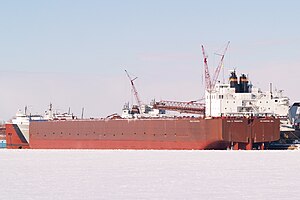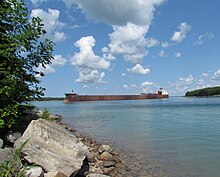
Lake freighters, or lakers, are bulk carrier vessels that operate on the Great Lakes of North America. These vessels are traditionally called boats, although classified as ships.

SS Arthur M. Anderson is a cargo ship of the laker type. She is famous for being the last ship to be in contact with SS Edmund Fitzgerald before she sank on November 10, 1975. Arthur M. Anderson was also the first rescue ship on the scene in a vain search for Edmund Fitzgerald survivors. The vessel's namesake, Arthur Marvin Anderson, was director of U.S. Steel, a member of its finance committee and vice chairman of J.P. Morgan & Co. at the time. The ship was launched in 1952 and is in active service.

USS Chiwawa (AO-68) is a former T3-S-A1 Kennebec-class oiler constructed for the United States Navy during World War II. She was the only U.S. Navy ship named for the Chiwawa River in Washington.

MV American Courage is a diesel-powered lake freighter owned and operated by Grand River Navigation. This vessel was built in 1979 at Bay Shipbuilding Company, Sturgeon Bay, Wisconsin and included self-unloading technology.
The Pickands Mather Group is an American company which provides shipping of coal and other bulk commodities, and the purchase, sale, and marketing of bulk coal. Founded in 1883 as Pickands Mather & Company, it once had the second largest shipping fleet on the Great Lakes in the 1910s and 1920s. The company was purchased by the Diamond Shamrock Corporation in 1968, which in turn sold it to the Moore-McCormack Resources in 1973. Moore-McCormack sold Pickands Mather's mining interests to Cleveland-Cliffs in 1986. Moore-McCormack then spun off the Interlake Steamship Company to James Barker and Paul R. Tregurtha in 1987. Pickands Mather was sold to a management group in 1992, and continues to operate as a private company.
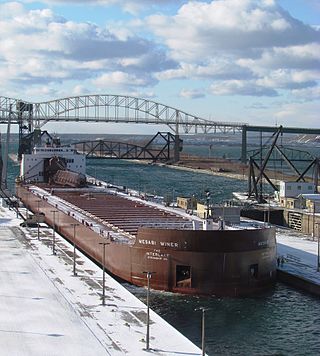
MV Mesabi Miner is a bulk carrier that operates on the upper four North American Great Lakes. She is one of the small number of vessels that are too large to travel through the Welland Canal that connects Lake Erie to the lowest lake, Lake Ontario.
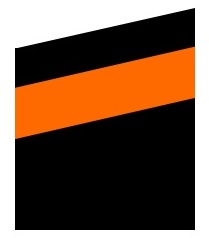
The Interlake Steamship Company is an American freight ship company that operates a fleet on the Great Lakes in North America. It is now part of Interlake Maritime Services.
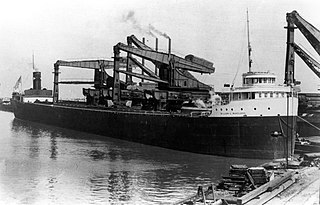
SS William C. Moreland was a 600-foot (180 m) long Great Lakes freighter that ran aground on Sawtooth Reef, Lake Superior on 18 October 1910, only a month after entering service. Visibility was poor due to the smoke from several forest fires, causing the William C. Moreland to ran full steam onto a reef. There were many attempts to salvage the ship, but eventually only the 278-foot (85 m) long stern was salvaged and was used to build the 580-foot (180 m) long Sir Trevor Dawson.

SS Ira H. Owen was a steel-hulled American lake freighter in service between 1887 and 1905. One of the first steel lake freighters, she was built in 1887 in Cleveland, Ohio, by the Globe Iron Works Company, and was built for the Owen Line of Chicago, Illinois. Early in her career, Ira H. Owen carried iron ore from Escanaba, Michigan. In April 1898, Ira H. Owen was chartered by the Baltimore & Ohio Railroad. She was sold to the National Steamship Company of Chicago, on December 30, 1899, for whom she frequently carried coal and grain. Throughout her career, Ira H. Owen was involved in multiple accidents and incidents.
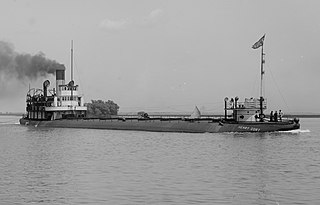
The Henry Cort was a 320-foot (98 m) long whaleback freighter. It sank four times during its career; finally running aground at Muskegon, Michigan in November, 1934. The ship broke apart over the winter and was scrapped in 1935.

The Henry A. Hawgood was an American steel-hulled, propeller-driven lake freighter that was built by the American Ship Building Company of Cleveland, Ohio for service on the Great Lakes of North America and Canada. She was used to haul bulk cargoes such as iron ore, coal and grain.

SS Willis L. King was a 600-foot-long (180 m), steel-hulled, propeller-driven American Great Lakes freighter built in 1911 by the Great Lakes Engineering Works of Ecorse, Michigan. She was scrapped in 1984 in Ashtabula, Ohio. Willis L. King is best known for her collision with the steamer Superior City on August 20, 1920, in Whitefish Bay.

SS D.R. Hanna was a 552-foot (168 m) long American Great Lakes freighter that operated on the Great Lakes from November 12, 1906 to her sinking on May 16, 1919 after a collision with Quincy A. Shaw. D.R. Hanna was like many other freighters, and was used to haul bulk cargoes such as iron ore, coal and grain.

SS Senator was a steel-hulled Great Lakes freighter that sank on Lake Michigan with the loss of nine lives and 268 Nash automobiles, on Halloween of 1929 after she was rammed in heavy fog by the bulk carrier Marquette. She lies in 450 feet (140 m) of water 16 miles northeast of Port Washington, Wisconsin. On April 12, 2016 her wreck was listed on the National Register of Historic Places.

The MV Kaye E. Barker is a self-discharging lake freighter owned and operated by the Interlake Steamship Company. She was originally built as the Edward B. Greene, and was later renamed Benson Ford before being sold to Interlake and named the Barker. It primarily hauls hematite pellets, stone, and coal across the North American Great Lakes.
Lake Frampton was a steam cargo ship built in 1918 by American Shipbuilding Company of Lorain for the United States Shipping Board (USSB) as part of the wartime shipbuilding program of the Emergency Fleet Corporation (EFC) to restore the nation's Merchant Marine. The vessel was employed in coastal trade during her career and collided with another steamer, SS Comus, and sank in July 1920 on one of her regular trips with a loss of two men.
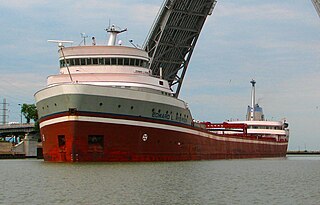
SS Edward L. Ryerson is a steel-hulled American Great Lakes freighter that entered service in 1960. Built between April 1959 and January 1960 for the Inland Steel Company, she was the third of the thirteen so-called 730-class of lake freighters, each of which shared the unofficial title of "Queen of the Lakes" because of their record-breaking length. She was not only the last steam-powered freighter built on the lakes but also the last one that was not a self-unloader. Since 2009, she has been in long-term layup in Superior, Wisconsin. She is one of only two American-owned straight deck lake freighters, the other being John Sherwin, built in 1958.

The SS Alpena is a lake freighter. She was built in 1942 by the Great Lakes Engineering Works in Ecorse, Michigan, to carry iron ore. She was originally owned by the Pittsburgh Steamship Company, a subsidiary of United States Steel. After also hauling grain in addition to ore in the 1960s and 1970s, the ship was put into storage in 1982.
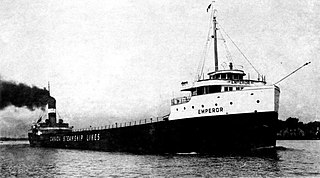
SS Emperor was a steel-hulled Canadian lake freighter in service between 1911 and 1947. She was built between 1910 and April 1911 by the Collingwood Shipbuilding Company in Collingwood, Ontario, for Inland Lines, Ltd. of Midland, Ontario. She entered service on May 3, 1911. Emperor was sold to Canada Steamship Lines of Montreal, Quebec. Under the ownership of Canada Steamship Lines, she carried a wide variety of cargoes, but most frequently iron ore to Point Edward, Ontario, where it would be transported to Hamilton, Ontario, by train. After the opening of the fourth Welland Canal, Emperor carried the ore directly to Hamilton. She was involved in several accidents throughout her career.

MV Mark W. Barker is a large diesel-powered lake freighter owned and operated by the Interlake Steamship Company. She is the first of the River-class freighters constructed for an American shipping company. MV Mark W. Barker is the first ship on the Great Lakes to be powered with engines that meet EPA Tier 4 standards.
